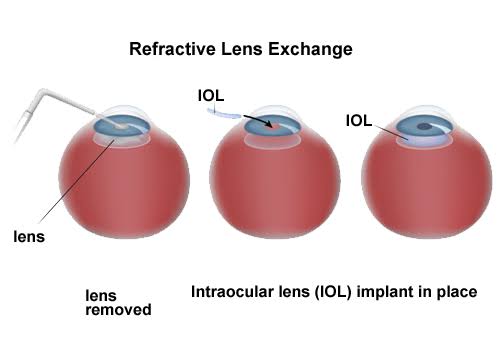REFRACTIVE LENS EXCHANGE ( RLE )
REFRACTIVE LENS EXCHANGE ( RLE )
Refractive Lens Exchange
Advancements in the technology of intraocular lenses (IOLs), which are used to replace the natural lens in our eye, have made Refractive Lens Extraction (RLE) an attractive option for patients ages 40-70 looking to reduce or eliminate their need for glasses and contacts. For some, this procedure may be a better alternative to LASIK.
Why do we need our lens exchanged?
When we are young, in our 20s and 30s, our lens is clear and elastic. It is able to change its shape to focus on objects at different distances, much like a camera lens. As we reach middle age however, the lens begins to become rigid, and we lose the ability to do this. This process results in requiring reading glasses to see well up close and is known as presbyopia.
Over further time, the natural lens will undergo both a gradual process of yellowing and a gradual process of clouding, eventually becoming opaque. Lenses which have begun to become opaque are called cataracts, replacing them is called cataract surgery.
While it used to make sense to wait until a cataract formed to replace your lens, recent advancements in technology have now made it worthwhile to consider having your lens replaced as early as your 40s, as doing so can eliminate your need for reading glasses, distance glasses, and/or contacts.

What are my options for new lenses (IOLs)?
Today, advancement in new lens technology has given Envision Lasik Centre the opportunity to offer several IOL options to best fit your needs and lifestyle. After eye measurements are taken, your doctor will help you decide which lens is right for you based on physical and personal factors. Some personal factors to consider are activities you’d like to perform without the need of glasses, specific distances you’d prefer to see clearly without glasses, and additional financial resources available to purchase more advanced technology lenses with greater benefits.
- Basic Monofocal IOL
Monofocal IOLs are basic artificial lenses that have one focusing distance. The lens can be chosen to focus for up close (reading), medium range (computer screen) or distance vision (driving). Most people will choose a monofocal IOL set for clear distance vision and then wear eyeglasses for reading or close range work. - Toric IOL for astigmatism
Basic lens implants are not able to adjust for astigmatism (an imperfection in the curvature of your cornea) which may also be affecting your vision. Toric IOLs are able to correct for astigmatism and, therefore, give you a better chance of good distance vision without glasses or contacts after your surgery. - Multifocal IOL
Multifocal IOLs provide both distance and near focus at the same time. The lens has different zones set at different powers and is designed so that your brain learns to select the right focus automatically. With multiple points of focus, one image is in focus at a time. - Advanced Technology Extended Depth of Focus IOL
When it comes to extended depth of focus IOLs, Price Vision Group is proud to offer the Tecnis Symfony® Extended Depth of Focus IOL. This revolutionary lens is the first and only presbyopia correcting IOL that provides a continuous full range of high quality vision. These lenses allow you to see clearly at near, intermediate and far distances. These IOLs also minimize side effects associated with multifocal IOLs like glares and halos around lights.
Am I a Candidate?
Anyone who is over the age of 40 and dependent on glasses or contacts is a potential candidate for the procedure, as well as anyone who has begun to develop cataracts. To find out if an advanced lens is the right option for you, come in for a free refractive screening, where we can help you determine the options best tailored to your lifestyle and eye physiology.
Start seeing better today! Call us Today!
About Us
- Dr A. Saibaba Goud is MS in Ophthalmology from Osmania University. He completed his Ph.D. in Ophthalmology in February, 1988 earning the distinction of being the first recipient of a Doctorate in Community Ophthalmology in India. Read More..
- Dr Advaith Sai Alampur completed his Fellowship in cornea and anterior segment at Sankara Nethralaya,Chennai. Read More..
Address
- Plot No 185, Road No 1 Beside Kennedy School, Opposite lane to Om Shanthi Foods, West Marredpally, Secunderabad-500026.
Address
- 3rd Floor, Vaishnavi Lemini Arcade, Doolapally Road, Above Ratnadeep Super Market, Devender Colony, Kompally, Hyderabad, Telangana 500014
